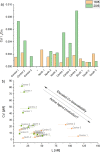Aqueous copper bioavailability linked to shipwreck-contaminated reef sediments
- PMID: 31267013
- PMCID: PMC6606755
- DOI: 10.1038/s41598-019-45911-8
Aqueous copper bioavailability linked to shipwreck-contaminated reef sediments
Abstract
Pollution from the grounding or sinking of ships can have long lasting effects on the recovery and dynamics of coastal ecosystems. Research on the impact of copper (Cu) pollution from the 2011 MV Rena shipwreck at the Astrolabe Reef (Otaiti), New Zealand, 5 years after the grounding, followed a multi-method and multi-disciplinary approach. Three independent measures of aqueous Cu using trace-element-clean-techniques substantiate the presence of high total, total dissolved (<2 µm) and elevated bioavailable Cu in the water column immediately above the aft section of the wreck where the highest sedimentary load of Cu was located. Intermittently elevated concentrations of strong Cu-binding ligands occurred in this location, and their binding strength was consistent with ligands actively produced by organisms in response to Cu induced stress. The recruitment of benthic invertebrates was modified at the high-Cu location. Taxonomic groups usually considered robust to pollution were restricted to this site (e.g. barnacles) or were the most abundant taxa present (e.g. foraminifera). Our results demonstrate that Cu-contaminated sediments can impose a persistent point source of Cu pollution in high-energy reef environments, with the potential to modify the composition and recovery of biological communities.
Conflict of interest statement
The authors declare no competing interests.
Figures







Similar articles
-
Inhibition of digestive enzyme activities by copper in the guts of various marine benthic invertebrates.Environ Toxicol Chem. 2002 Jun;21(6):1243-8. Environ Toxicol Chem. 2002. PMID: 12069309
-
Understanding ship-grounding impacts on a coral reef: potential effects of anti-foulant paint contamination on coral recruitment.Mar Pollut Bull. 2002 Feb;44(2):111-7. doi: 10.1016/s0025-326x(01)00128-x. Mar Pollut Bull. 2002. PMID: 11981977
-
Impact of water temperature and dissolved oxygen on copper cycling in an urban estuary.Environ Sci Technol. 2007 Sep 1;41(17):6103-8. doi: 10.1021/es062719y. Environ Sci Technol. 2007. PMID: 17937288
-
Pesticidal copper (I) oxide: environmental fate and aquatic toxicity.Rev Environ Contam Toxicol. 2011;213:1-26. doi: 10.1007/978-1-4419-9860-6_1. Rev Environ Contam Toxicol. 2011. PMID: 21541846 Review.
-
Effects of shallow-water hydrothermal venting on biological communities of coastal marine ecosystems of the western Pacific.Adv Mar Biol. 2006;50:267-421. doi: 10.1016/S0065-2881(05)50004-X. Adv Mar Biol. 2006. PMID: 16782453 Review.
Cited by
-
Shipwreck ecology: Understanding the function and processes from microbes to megafauna.Bioscience. 2023 Dec 19;74(1):12-24. doi: 10.1093/biosci/biad084. eCollection 2024 Jan. Bioscience. 2023. PMID: 38313562 Free PMC article. Review.
References
-
- Dobie, G. Global claims review. (Allianz Global Corporate & Specialty, 2014).
-
- Dimitrakakis E, Hahladakis J, Gidarakos E. The “Sea Diamond” shipwreck: Environmental impact assessment in the water column and sediments of the wreck area. International Journal of Environmental Science and Technology. 2014;11:1421–1432. doi: 10.1007/s13762-013-0331-z. - DOI
-
- Leichenko, R. & O’Brien, K. Environmental Change and Globalization: Double Exposures (2008).
-
- Battershill CN, Ross PR, Schiel DR. The MV Rena shipwreck: time-critical scientific response and environmental legacies. New Zealand Journal of Marine and Freshwater Research. 2016;50:173–182. doi: 10.1080/00288330.2015.1134593. - DOI
-
- Chapman, P. In The Telegraph (2012).
Publication types
LinkOut - more resources
Full Text Sources

